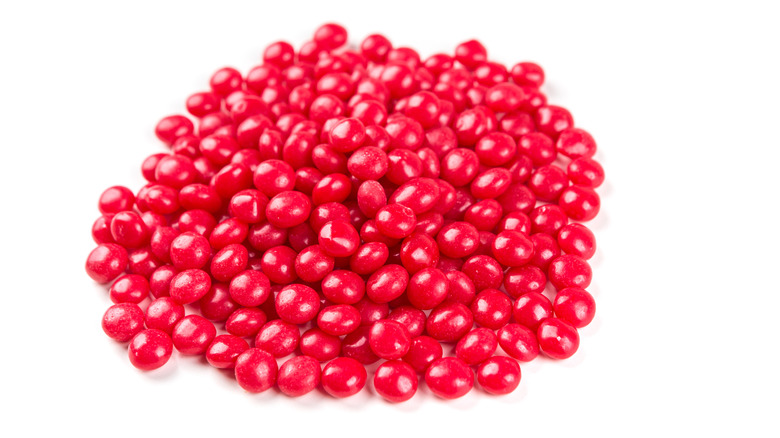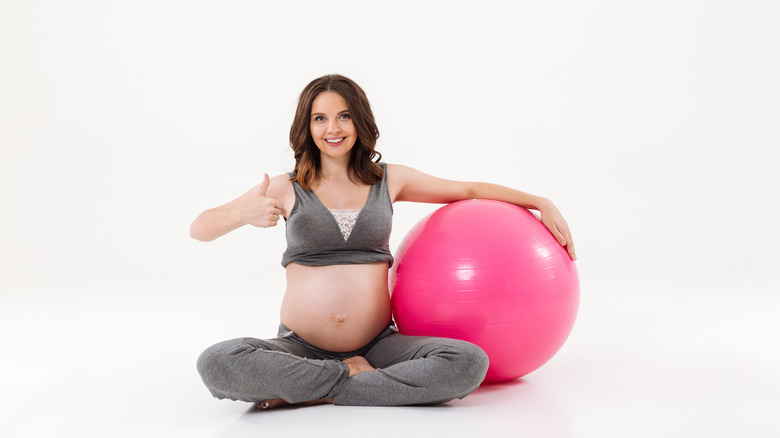Essential Life Hacks For Pregnant Women
Pregnancy is a time unlike any other in your life. You're super excited to be welcoming a new life into the world, but your body is also changing more than it will at any other time in your adult life. If you're one of the many pregnant women who struggle with various unpleasant symtoms, you may find yourself wondering if you simply have to live this way for nine months. You're nauseous, you seemingly have to pee every 10 minutes, and then there's the birth to prepare for. Luckily there are a few hacks to smooth the process. I went to the experts to find out the best life hacks for pregnant women.
Eat hot tamales and atomic fireballs for nausea
You've probably heard you should drink ginger tea to soothe your nausea, but did you know that you can also use hot tamales and atomic fireballs for the same purpose? Dr. Aimee D. Eyvazzadeh, reproductive endocrinologist told me, "The use of cinnamon to relieve nausea and vomiting is nothing new. Herbalists have long known of the power of cinnamon, and many recent published scientific studies are also demonstrating the same. Cinnamon is a side-effect-free way of reducing symptoms that are so commonly seen in pregnancy."
She added, "I tell patients to suck on the candy and don't necessarily eat the entire candy to help with nausea. But just warning you, after pregnancy you may have a really hard time eating a hot tamale again."
Take Unisom to help with nausea
First trimester nausea can take a huge toll on your life. But luckily there's an over the counter pill that will help you feel less nauseated without emptying your wallet. Plus it's completely safe for pregnant women, unlike some of the other medications out there. Dr. Eyvazzadeh told me, "You've heard of Kim Kardashian marketing diclegis for nausea. It's pregnancy category A, which means it's safe in pregnancy. But if you need relief in a pinch, taking unisom with b6 is almost just like diclegis and no prescription needed. Unisom tabs are super small an easier to swallow so they may work better."
However, Dr. Eyvazzadeh warned, "Before you try any of these pregnancy hacks do talk to your doctor. Severe nausea could be a sign of untreated hyperthyroidism, and that's something you'd want to know."
Distract yourself from having to pee with physical stimulation
One of the joys of pregnancy is having to pee all the time. That's not a problem — unless you find yourself trapped in the car. If that happens, Bailey Gaddis, birth doula, childbirth preparation educator, and author of Feng Shui Mommy: Creating Balance and Harmony for Blissful Pregnancy, Childbirth, and Motherhood has a suggestion for you.
She told me in our interview, "Murphy's Law says most pregnant women have to pee the most when they're stuck in the car. If you're ever in traffic with a full bladder, or have a ways to go before the next bathroom, redirect attention from your bladder by using one of the following touch techniques." She goes on to explain eactly what to do: "If you're not the one driving, direct attention to your arm by lightly grazing the back of your fingertips across your arm. This light touch helps to stimulate your nerve endings and release endorphins. If you're the one behind the wheel, lightly graze one thumb across the side of the other."
Put peppermint essential oil in your toilet bowl to help you pee
On the flip side, if you're having trouble peeing, Gaddis has a tip for that as well. She told me, "Pregnant women feel like they have to pee almost all of the time, but because of pressure on the bladder and swelling in their vaginal region, it can sometimes be difficult to fully empty the bladder." She goes on to reaveal, "My number one, top secret tip, that all my pregnant clients love, is to put a few drops of peppermint essential oil in the toilet bowl if you ever have trouble urinating. Peppermint oil is so effective because its vapors help to dilate the urethra. This tip is especially helpful during childbirth when the pressure on the bladder and swelling in the vaginal region is greatly intensified."
On a personal note, she told me, "I learned this tip when I was birthing my son and had to pee so bad I was crying — the pain from my full bladder was worse than the sensations of my contractions! A nurse made the suggestion and it opened up my world to blissful pain-relief."
Practice relaxation techniques with your partner before bed
While you might find yourself dozing off throughout the day, especially in the first trimester, you may have trouble falling asleep at night. If that happens, take it as an opportunity to bond with your partner. Gaddis told me, "To ward off insomnia, tell your partner it's essential to practice birthing relaxation techniques like pressure point work, light touch massage, scalp, jaw, and foot massage, and guided meditation together before bed to ensure you're both fully prepped for birth."
Doing these relaxation techniques has multiple benefits. Gaddis continues, "Not only can this get you nightly massages, but will serve to deepen your bond with your partner, fill your birthing tool kit, and help you drift into deep and restorative sleep. My clients love when I tell them that their only homework is to practice these relaxation tools with their partner every night."
Meditate before eating
When you're pregnant, your cravings can get out of control. But it's essential that you control your weight gain, for both your health and your baby's. Meditating before meals can help you make better food choices and stay healthy throughout your pregnancy. Gaddis told me, "Meditate for three minutes before preparing any meal, or going into a restaurant. Pregnant women are often led by the cravings in their mind first, and the needs of their body second. When you take a few quiet moments to clear the mind before making food selections, you're more likely to tune into what your body actually needs and desires, instead of what your mind is saying sounds good."
Gaddis shared this client story: "I once worked with a pregnant woman who said she instinctively reached for anything salty and crunchy. She said she had low energy and was always bloated but that salty crunchy food was the only category of nosh that sounded good. When I had her begin the pre-meal meditations, she reported being more in tune with her body and more inclined to make healthy choices. She even said that she was able to become more creative with her salty crunchy cravings and opt for carrot sticks with honey mustard, or celery and peanut butter, instead of chips and pretzels."
Swap the talk test for the sing test during aerobic exercise
Trainers often suggest that you use the "talk test," in which you see if you can talk comfortably during exercise, in order to measure the intensity of your workout. While this test works well, according to Helene Byrne, internationally recognized prenatal and postpartum fitness and exercise expert and founder of BeFit-Mom, the sing test works even better. She told me, "Swap the talk test for the sing test during aerobic exercise. When we speak, it's far too easy and common to take small, barely noticeable inhalations. So while you may not be out-right panting, you can unintentionally overshoot your ideal prenatal aerobic training zone without recognizing it in your body.
Here's what she suggests instead. "Sing a simple song like Row, Row, Row Your Boat and if you need to take a big inhale between the first two lines, in this case, "boat" and "gently," then you should lower your intensity."
Force yourself to only read during exercise
While many women worry about the safety of their workouts during pregnancy, it's actually very important to workout when you're pregnant, even if you never stepped foot in the gym before you conceived. If you're a reluctant exerciser, Gaddis recommended, "To convince yourself to exercise, find a book you've been wanting to read, and download [an audio version] on your phone. Then, commit to only listening to the book when you're out for a walk. Dying to know what happens next will encourage you to tie up those tennis shoes and get moving."
Take deep breaths to relieve anxiety
Even if you're not normally an anxious person, you may find yourself worrying a lot when you're pregnant. There are so many new things to process and consider, and it can be overwhelming. If that sounds familiar, you'll love this hack from Gaddis. She told me, "If pregnant anxiety ever washes over you, remember that it's almost impossible to become stuck in anxiety when you're taking deep breaths."
She continued to tell me some concrete examples of what to do: "If stress or fear ever sneaks into your mind, practice the following breathing technique: take a deep breath and envision yourself easily finding your breath, take in another deep breath and envision it filling your head and clearing your mind, then take another deep breath and envision it filling your chest and warming your chest. Repeat the cycle as often as needed."
Instead of losing yourself in anxiety, listen to your breath and let it lead you to a more peaceful place.
Do prenatal core exercises
When you have a baby in your uterus, it's common to experience pain. You can set yourself up for a smoother third trimester, however, by doing prenatal core exercises. Byrne told me, "Prevent common pregnancy problems like diastasis recti, pelvic instability, and back pain with simple prenatal core exercises that build/maintain strength in the transverse abdominis, or TvA. The TvA is our body's internal corset and when contracted, compresses the abdomen. Performing these safe moves throughout pregnancy will not just prevent/lessen the severity of these issues, but will also greatly aid in the pushing phase of labor, as the TvA is our primary, voluntary expulsion muscle."
If you want to see the prenatal core exercises in action, check out this video on Byrne's YouTube channel.
Exercise on a yoga ball to strengthen your pelvic floor
An episiotomy is a procedure during childbirth in which your doctor or midwife will make a cut in your perineum, which is the tissue between the vagina and the anus. This procedure is only needed if your baby can't fit through your vagina without it. Episiotomies and vaginal tearing don't happen during every birth, and you can prevent their necessity by exercising on a yoga ball.
Byrne told me, "When you sit astraddle a large exercise ball, your pelvic floor is in contact with the ball. As you exercise on the balls, whether simple stretches, with free weights, or stability moves, the membrane of the ball and your pelvic floor will function as one unit. As your weight shifts on the ball, your pelvic floor will undergo a small amount of upward pressure which gently stretches your pelvic floor muscles, which builds elasticity."
In addition, Byrne suggested, "After 36 weeks gestation, you can gently bounce on the ball for 5 minutes a day, to more effectively build elasticity in your pelvic floor. Practicing Kegels on the ball is great too."












